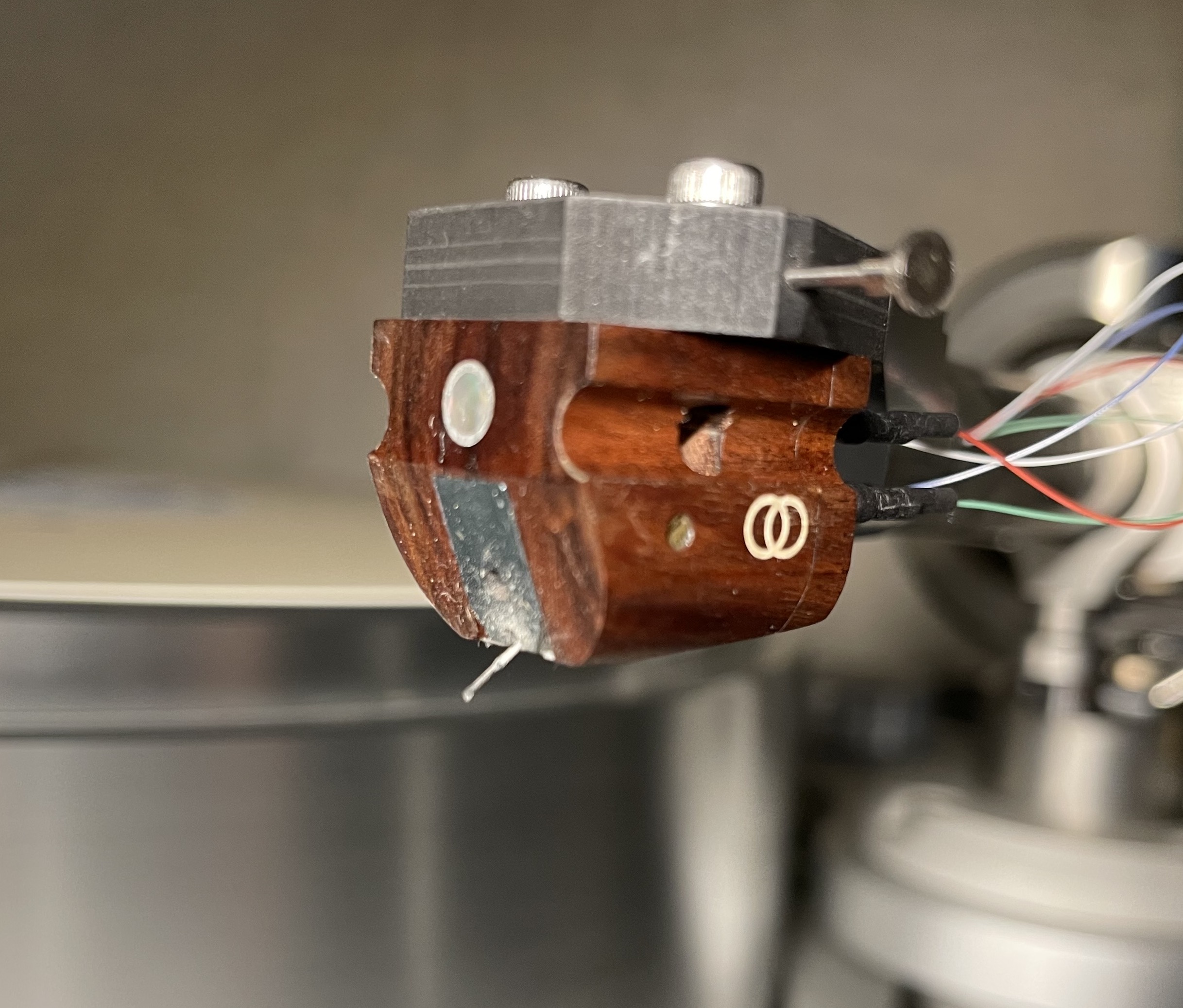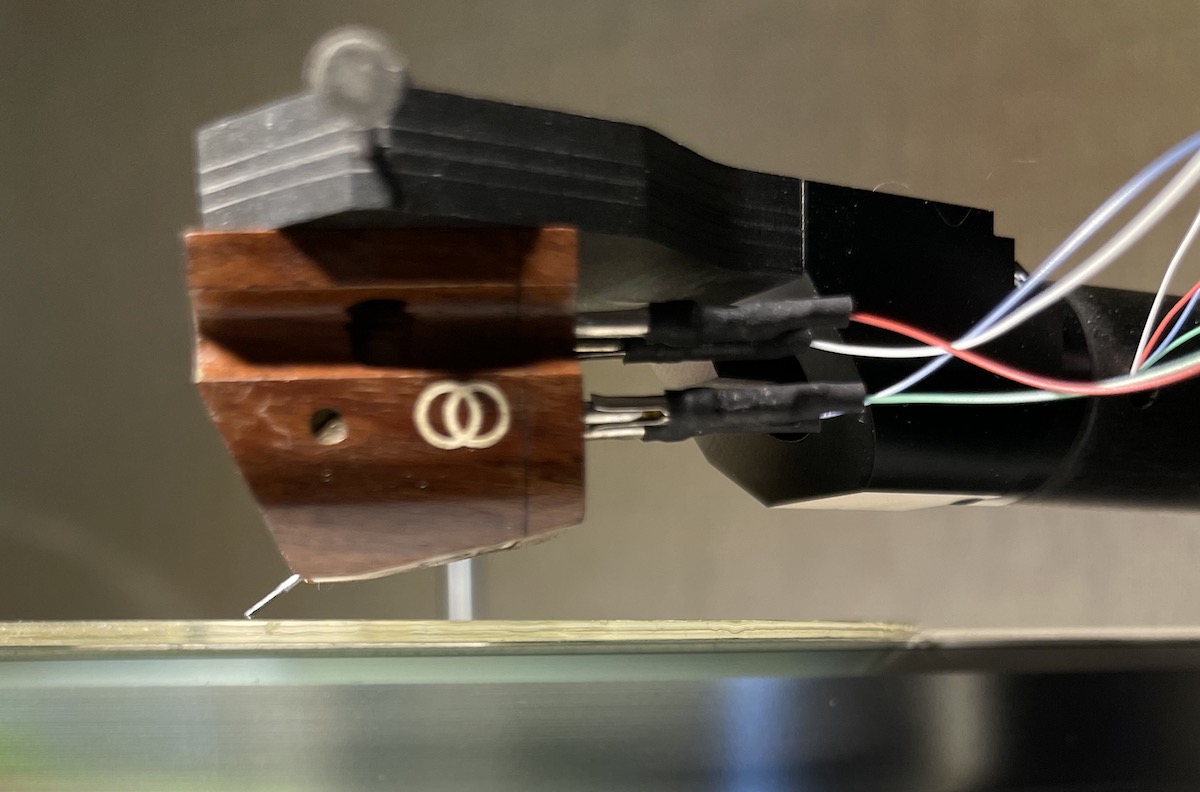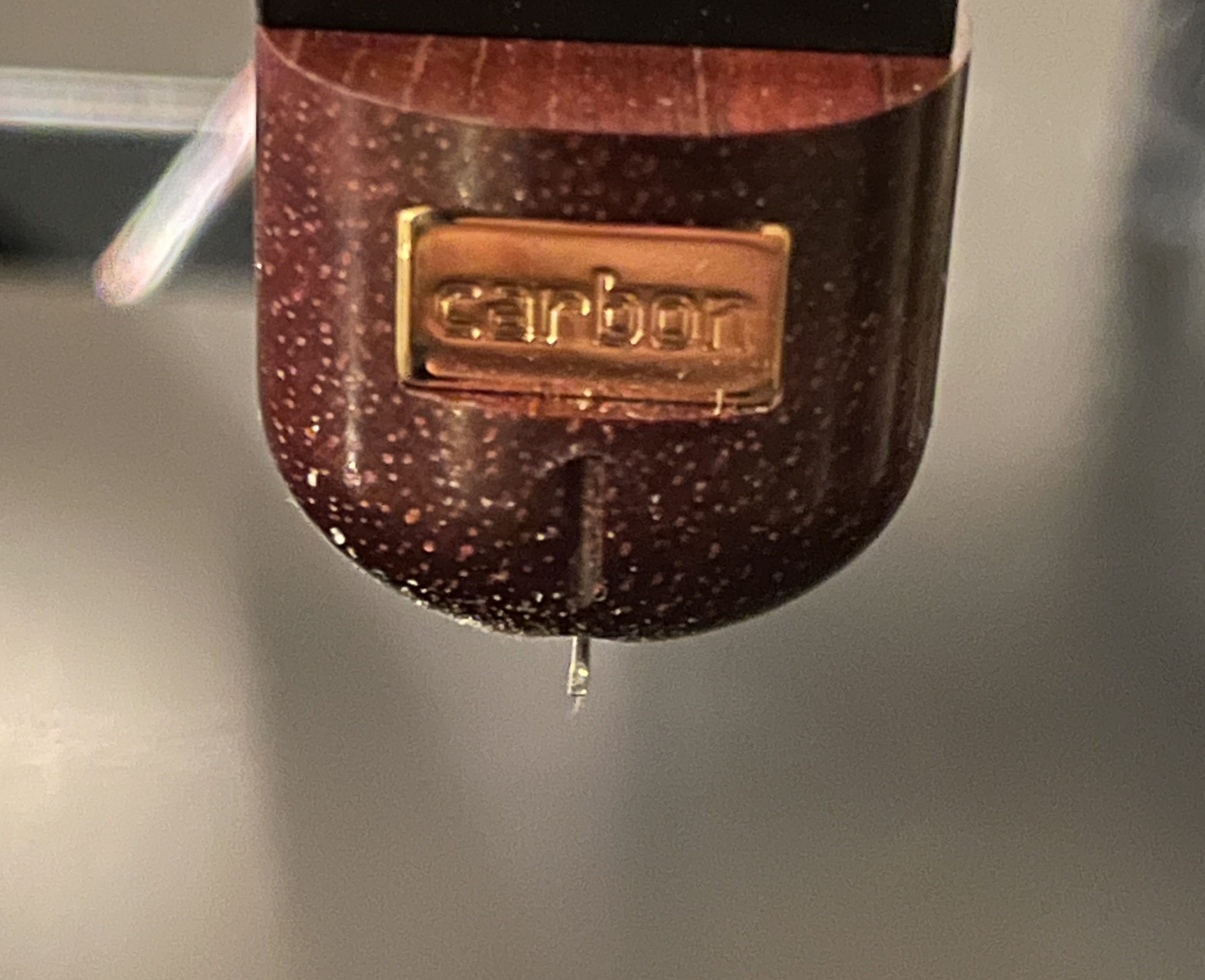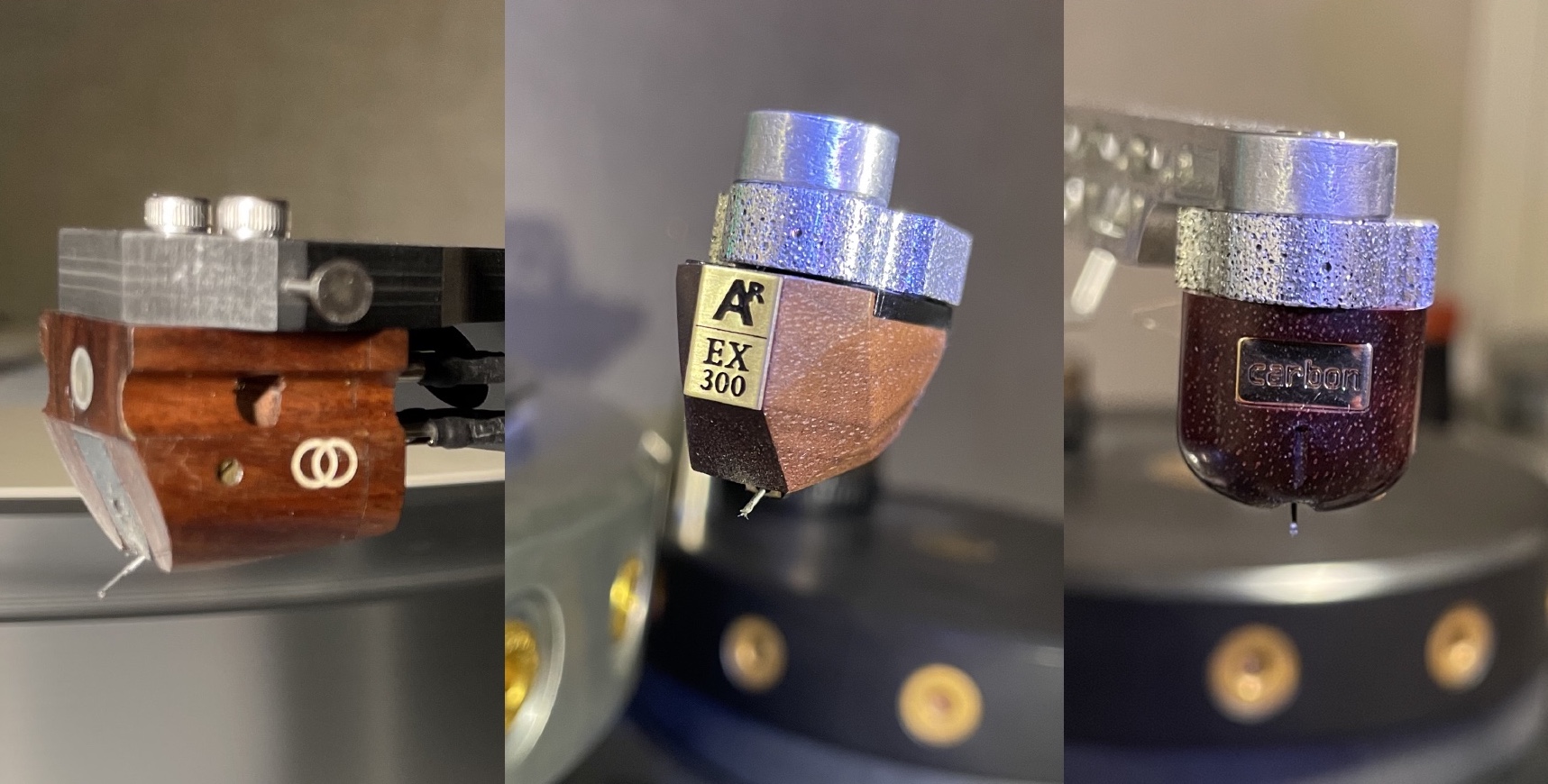Three Wooden Bodied Moving Coil Cartridges Reviewed and Compared
priced from $2999 to $6600
Rega likes to point out that cartridges and turntables are “vibration measuring devices.” That sounds simplistic, or fanciful but it’s true. The stylus wiggling its way through the record groove unleashes a large amount of vibrational energy. Most of it reaches the intended target, which is either magnets or coils. But some of that energy causes the cartridge body to vibrate—we’ll ignore in this discussion unwanted energy returning to the record grooves or making its way into the tonearm and turntable itself.
The unwanted vibrational energy produces both amplitude and time-based distortions that results in various amounts of what we’ll call “additive sonic mud”. It’s not what’s in the groove and it’s best for the cartridge designer to deal with the vibrational resonances.
Designers at the top of the cartridge market can use SLM (Selective Laser Melting) to create impossible to machine anti-resonance shaped cartridge bodies of exotic, self-damping materials like Titanium. Some designers use asymmetrical shapes to break up standing waves and other resonant behavior.
Rather than attempting to eliminate resonances, some designers choose to “tune” the cartridge’s resonant behavior using tiny brass cylinders embedded into the cartridge body or fabricate bodies of stone or exotic wood—or combinations of all these ideas.
The designers of these three cartridges have chosen to “tune” their cartridge’s sound using different kinds of wood, though the ultimate “tuning” goes beyond the chosen wood and is a result of all the materials used in the design and manufacturing process. The wood though, impacts the sound, or they wouldn’t bother using it. The same is true of the distinctive sounding “wooden tuning” Grado line of moving iron cartridges.
The Tedeska Torres DST201us
 Guitarist Hyun Lee hand-builds Tedeska cartridges in Berlin, Germany. If you wish to learn more about his design philosophy and how he came to become a cartridge designer as well as a musician, you’ll find the story on the website You’ll also note the site’s colors are mostly shades of brown. Like wood. Under FAQs you can learn about the full Tedeska lineup and other interesting facts, but this is a cartridge review not a company assessment. Lee will consult with you before building your cartridge to help deliver your desired results.
Guitarist Hyun Lee hand-builds Tedeska cartridges in Berlin, Germany. If you wish to learn more about his design philosophy and how he came to become a cartridge designer as well as a musician, you’ll find the story on the website You’ll also note the site’s colors are mostly shades of brown. Like wood. Under FAQs you can learn about the full Tedeska lineup and other interesting facts, but this is a cartridge review not a company assessment. Lee will consult with you before building your cartridge to help deliver your desired results.
The DST in the name stands for Dynamischer Stereo Tonabnehmer (dynamic stereo pickup). The FAQ section makes clear, in case you are wondering, that other than the DST in the cartridge name, there’s no relationship technical or otherwise between Tedeska cartridges and Neumann’s classic DST, a version of which is now manufactured in Russia as the TZAR DST.
The Torres DST201us is the pure silver wired version of the Lacote DST201uc but with a Samarium-Cobalt replacing the Lacote’s Neodymium magnet. The body is of Tonewood, Brass, Bone and Nacre. Tonewood? It’s not a species of tree but rather a general term for a variety of woods possessing tonal properties useful for crafting stringed or woodwind instruments. Brass needs no explanation. I’m not asking where the bone came from, though based on site literature it’s not ivory. Nacre is another word for mother-of-pearl. Clearly a musical instrument is in the cartridge’s genetic makeup, but if you read the Developing FAQ you’ll find that a great deal of solid tech goes into the designs.
On the less fanciful side of the equation, the Torres is fitted with a Boron cantilever, though inexplicably the stylus profile is not among the specs. I noted (using a USB microscope) what appears to be a line contact stylus.
Later I learned that Lee installs the styli into the cantilevers himself, rather than buying them pre-assembled—for sure a tricky procedure. He calls his standard stylus profile the “Tedeska Multi-cut”. The importer at Solypsa Audio says that compliance, stylus profile and various other factors can be “discussed” with Mr. Lee and that he can accommodate various needs. It takes about fourteen weeks for a cartridge to be delivered once it’s ordered.
Other features for the “standard Torres”, which was delivered for this review, include pure silver coil wiring on a magnetic core and double-hardened pure silver contact pins.
Specs:
Output: .3mV± 2dB@1kHz (5.6cm/sec)
Frequency response: 20Hz-35kHz
Channel separation: >27dB@1kHz
Impedance: appx 8 ohms
Weight: Appx 7.5g± 0.5g
Recommended VTF:1.7-1.9g (recommended 1.8g)
Compliance: 12x10-6 cm/dyne @10Hz
I’d reviewed the DST201ua MC cartridge in 2019 at my “previous endeavor” and enjoyed listening to it, describing it as an “exquisite, handcrafted specimen….” That cartridge’s design took a different generator approach, using a non-magnetic coil former, which required more wire turns to achieve its output and thus was spec’d to have around 18ohm internal impedance. The Torres’ magnetic former produces similar output with fewer coil turns and has a 10 ohm lower internal impedance.
A hand-filled out card accompanying the elegantly packaged cartridge offers the individual specs that were very close to the published ones, though visually the 23 degree VTA spec seems at least 10 degrees off, perhaps closer to 33 or 35 degrees off. Look for yourself. You’ll also see that the cantilever is exposed and there’s no stylus guard. You have been warned.
 The install and listening period occurred months ago and am just getting to write up this triple header, for which I apologized to all three importers. At the time of this install I’d been listening to Intervention’s reissue of The Fantastic Expedition of Dillard And Clark featuring Doug Dillard and Gene Clark along with future Eagle Bernie Leadon and former Byrd Chris Hillman. It’s a short but sweet record filled with exquisite picking and superb harmonies.
The install and listening period occurred months ago and am just getting to write up this triple header, for which I apologized to all three importers. At the time of this install I’d been listening to Intervention’s reissue of The Fantastic Expedition of Dillard And Clark featuring Doug Dillard and Gene Clark along with future Eagle Bernie Leadon and former Byrd Chris Hillman. It’s a short but sweet record filled with exquisite picking and superb harmonies.
It’s the first record played, and it resulted in an audible “wow”! I may have written this before about another cartridge reproducing this record, but this “wow” was bigger. Gene Clark’s voice didn’t sound recorded. It sounded “live”, solid and three-dimensional between the speakers, rich with natural textures, yet the acoustic guitar transients were sufficiently precise and fast to avoid the soggy uninvolving sound that more than a few cartridges on the warm side deliver that some enjoy but count me out!
Playing that record lit the string quartet, solo cello, violin concerto and acoustic guitar fire, which brought out Capitol mono Laurindo Almeida records (even though the cartridge is stereo—I used the CH Precision P10’s mono setting).
The Torres delivered live acoustical jazz recordings effectively, though it was better on reed instruments than on brass, where its slightly subdued nature shortchanged somewhat the hard edge transient that makes brass brass, though it impressed in the “burnished brass” department.
Percussion was somewhat of a mixed bag: on great recordings drum skin was as convincing as it gets, timbrally and texturally, but cymbal “ring”, rivet detail and shimmer took a slight hit as did “air” generally, but again not to where room ambience was sucked dry—and of course this is somewhat dependent upon your speaker’s tonal balance and your sonic tastes.
The usual test “suspects” The Weavers Reunion At Carnegie Hall (Classic Records 45rpm single-sided box set) and Joan Baez In Concert (VSD 2122)—the record with “Babe I’m Gonna Leave You” that grabbed Jimmy Page’s attention and certain aspects of both demanded attention—Ronnie Gilbert’s voice, the full-bodied acoustic guitar strums, the sound of feet tapping the stage—all were delivered with full expressiveness, though the hall sound—reverberant space and the stage back wall— not as expansive as it can be and the guitar body was more prominent than was the strum itself, though it was not muted or tamped down. The balance was artfully accomplished.
The Baez record presented her quavering soprano with magnificent authority but tucked away a bit of the hall ambience and not surprisingly emphasized the guitar body over string pluck. Clearly a worthwhile tradeoff as I planned on listening to the opener and stayed the entire concert!
No one listening to this cartridge would be surprised to learn the designer is also a musician and not a technocrat. Though I hesitate to use the word, the Torres is musical —meaning, even with less-than-ideal recordings it manages to find the musical centers and deliver them. Most importantly, the Torres produced exceptional image solidity and focus, which helped produce rhythmic authority and “punch”.
Cartridges designed by technicians tend to be more accurate in terms of frequency balance and less forgiving, letting you know more of what’s on the record, rather than delivering a musically pleasurable experience. The reality is that many recordings are not great, and the microphones used have tipped up top ends. The Torres pleasingly diminishes that problem without damaging the goods. However, the Tedeska Torres is not the idea rock’n’roll cartridge, nor would that probably surprise or disappoint designer Hyan Lee! Although, its rich, midrange-centric balance is such that you could play and enjoy a band like Little Feat or The Band because I certainly did.
The Torres’s microdynamic performance—it’s ability to reproduce small dynamic shifts—was very good, something “thicker” sounding wood bodied cartridges often don’t do well. It’s macrodynamic performance was good, especially considering the moderate (in today’s high-performance market) price, but there’s more “slam” to be had if you are willing to spend more. I think buyers interested in this cartridge care more about the cartridge’s timbral richness and well-saturated colors than about “slam”.
The VTA Issue
The unusually high VTA results in a few things, one of which is excellent tracking (which is not the same thing as tracing). There is so much online confusion between VTA and SRA. Vertical Tracking Angle and Stylus Rake Angle are two different, though related things. Raising or lowering the arm without first knowing the actual VTA and SRA by measuring it microscopically is just a lot of talk. If SRA is 87 degrees with the arm parallel to the record surface (as can be found in defectively built cartridges—and price is not the determining factor!), but you haven’t measured that and you start playing with height, you’ll never achieve the correct setting, which is around 93 degrees SRA give or take a degree.
High VTA as on the Torres, means greater downforce (use your finger as a cantilever and you’ll get it) and better tracking, but it also means (in the simplest of terms) that greater force will be applied on one side of the vertical modulation and less on the other, which can result in uneven groove tracing. But this is a discussion for another time.
The Torres SRA was not terribly “off” but the VTA was. There was no point in trying to lower the VTA because getting it anywhere near 20 or so degrees would put the back of the arm on the record, so I did the listening with the arm parallel to the record, which set the SRA reasonably well and certainly wasn’t a contributing factor to the sonic results.
I’ve read many forum comments from happy Tedeska cartridge owners and most of them refer almost exclusively to classical acoustic music. That’s the target audience for the Torres and that makes sense to me based on the listening I did. Considering the price of around 6200 Euro (around $6500 today) for a beautifully made, hand-built work of art with carefully considered “tech” (see the website) other than the VTA discrepancy, it’s easy to understand why Tedeska has successfully established itself in a well-considered niche. Imported by Solypsa Audio http://solypsa.com/
The Analog Relax AR-MCC-EX300
 The Analog Relax cartridge lineup features wood bodies throughout. The EX300 sits on the bottom rung of the Analog Relax cartridge ladder. At the top, the EX2000 features “Spruce harvested from Italy same as Stradivarius”. Not sure of the price, but one down from that is the $17,500 EX1000 I reviewed in 2021 at my previous endeavor, when it was then the top of the line and cost $16,000, which is still quite a chunk of change. However, it is among the most pleasure-producing cartridges I’ve ever encountered.
The Analog Relax cartridge lineup features wood bodies throughout. The EX300 sits on the bottom rung of the Analog Relax cartridge ladder. At the top, the EX2000 features “Spruce harvested from Italy same as Stradivarius”. Not sure of the price, but one down from that is the $17,500 EX1000 I reviewed in 2021 at my previous endeavor, when it was then the top of the line and cost $16,000, which is still quite a chunk of change. However, it is among the most pleasure-producing cartridges I’ve ever encountered.
The EX1000’s body is fashioned from 2000 year old Yakasugi Cedar wood. Yakusugi cedar has a fascinating back story that seeks to explain its effect on the sound—as do all cartridge wood varieties from snakewood in the Miyajima Labs Madake special edition to Cocobolo in Grado's Epoch 3. All of the wood bodied cartridges have a story, and all have a somewhat different wood-dependent sound. The more exotic the name, the more exciting it is!
Analog Relax carves the $3995 EX300’s body from a chunk of plain old bee’s wax coated walnut—nothing exotic. The company’s site says it’s the same wood used for guitar sides, necks and backs. The cantilever is aluminum that the company, ZOOT Communication (the founder is a Zoot Sims fan) says is slightly thicker than what’s used by EMT and other cartridge manufacturers. A special new bonding material it calls “IF” is claimed to produce a stronger cantilever/ elliptical stylus bond, which results in “higher resolution”. That makes sense. The company cautions against using (or overusing) commercially available liquid stylus cleaners because it may adversely affect the adhesive bond.
The EX300 features “multiple Neodymium magnets” and outputs .5mV with a 15 ohm internal impedance, which suggests more than a few coil turns of “high purity copper wire”. Suggested tracking force is 2.0 grams. In other words, this is pretty much “standard fare”, which doesn’t explain the inexplicable: how Analog Relax manages to produce a similar “relaxed” and inviting sound from this cartridge as it does from the far more costly EX1000. Not saying it’s as special because, while its personality is in the same camp as the 1000, the 300 is not quite as mesmerizingly “kiss of richness” enticing, nor does it summon forth the same level of detail, but then it's one quarter the price of the EX1000.
Instead, it produces a relaxing upper midband ‘bloom” that’s not excessive to the point of producing an annoying haze but it does obscure detail somewhat in that part of the bandwidth. The EX300 is probably not the idea rock cartridge but I used it to audition a reissue of REM’s 2008 album Accelerate. The original was a double 45 mastered by Stan Ricker. The reissue is at 33 1/3. The point here is not a comparison of the two versions of Accelerate but rather of the EX300 versus the far more costly Lyra Atlas SL Lambda because that’s what was on the other tonearm.
The mix is a compressed, one-dimensional crushed affair, yet through the Atlas Michael Stipe’s voice managed to exist in its own space and the bass line was well-defined. The midrange guitar “jangle” also managed clarity within its narrow space. Through the EX300, the bass lines were weaker and less pronounced, the midband push softened the rhythmic thrust and Stipe’s voice was co-mingled with the guitars. Based on that and other musical excursions the EX300 would not be my $3995 choice for rock music.
Jazz and classical was another story. On Rufus Reid Presents Caelan Cardello record I’m releasing with Robin Wyatt, the softer, easier presentation will appeal to some listeners just as the Air Force 3 Premium did over the OMA K3 turntable in the recent YouTube video comparison. The EX300 produced a “fleshier” sound that gave Rufus Reid’s bass more body while it diminished somewhat the attack. Caelan’s piano also had a warmer expansive midrange that still produced a legitimate Fazioli sound. Inserting the EX300 into the system was almost like going from a solid state to a tube phono preamp. It produced a ‘global’ shift towards full and rich without excess. If you’re looking for a cartridge that can add midband lushness and bloom and one that can “flesh out” a dry solid-state system without adding excessive “bloom”, the EX300 would be an excellent choice.
Specifications:
Coil: 6N high purity copper
Cantilever: Aluminum
Stylus: Elliptical pure diamond with IF adhesive bonding
Body: Tone wood walnut shaving out of solid wood Beeswax finish
Output voltage: more than 0.5mV (1KHz)
Impedance: 15Ω
Tracking force: 2.0 gram
Miyajima Labs Carbon

Miyajima Labs produces a wide range of cartridges, all featuring wood bodies and the company’s unique “cross-ring” construction that centers the coil at the construction’s fulcrum point rather than at the damper.
Rather than clarifying this here, watch the video:
That video helps explain why throughout the Miyajima line the cartridges produce a very “direct” and “fast” sound, though of course the choice of wood for the bodies also influences the final sonic result. The designer says he made the main body with wood “to maintain a splendid sound”. The company’s English language translations are not great and while at first there was a certain charm to it, at this point it would make more sense to get good translations and update the pages. For instance, this part of the construction description has been there for many years: “And it is fixed through a rubber damper in York.” And then there’s this description of the reaction to listening to the Miyajima Labs Destiny: “When you finish listening to the LP, you will feel like clapping players unintentionally.”
Miyajima Labs uses various stylus profiles and cantilever materials including cactus for the Saboten and bamboo for the Madake and Destiny—and not just any bamboo, but special bamboo. When I compared the standard Madake with a limited edition version made of Snakewood, I put the money down for Snakewood, which produced great transient ‘snap’, detail and “speed”.
The $2999 Carbon is among the least costly Miyajima Labs cartridges and yet for my tastes it’s right near the top. The body is of Satine, an especially dense South American wood that’s popular with guitar manufacturers for acoustic guitar sides and backs and for fretboards on electric guitars, and gun and knife manufacturers where it’s used for handles.
Miyajima pairs it with a detail resolving line contact stylus fitted to a thinner than normal (for Miyajima Labs) aluminum cantilever into which has been inserted carbon nanofibers that add stiffness.
Output is relatively low at 0.21mV and with its “about” 16 ohm internal impedance it’s borderline useful into a transimpedance phono preamp (of course if you have one of those try it!) so be sure your voltage based phono preamp can deliver around 60dB of low noise gain. The Carbon’s relatively low compliance of 9x10-6 cm/dyne makes it a good match for relatively high mass arms.
The combination of dense wood, stiff cantilever and line contact stylus produces sound that combines speed and “punch” with sharp (but natural) transient response plus supple textures and a neutral overall tonal balance. The result is an agile-sounding cartridge that works well on rock and acoustic jazz and because it doesn’t neglect the supple musical core, is also pretty good with symphonic music but if your sonic aim is to move towards something on the warmer side, which would have been the now discontinued Miyajima Labs Takumi-L., you’ll have to look elsewhere.
The Carbon’s bottom octaves are particularly “punchy”, powerful and rock-solid. The test pressing of the upcoming UHQR Aja was particularly well-served by the Carbon, yet it also revealed the surprisingly soft sounding Pretzel Logic UHQR.
The Carbon was installed when I was taking notes for a review of the ECM reissue of Old and New Dreams (ECM 1154 450 5344) that I compared to the original American Warner Brothers ECM release obviously cut from a tape copy. On “Guinea” Don Cherry’s gorgeous side one closer, the Carbon made clear the reissue’s more highly resolved reverb trail following the trumpet and the more pronounced transient attack of Charlie Haden’s bass. The Analog Relax EX-300’s softer, warmer presentation somewhat obscured the differences, though no doubt the EX-300 will sound more pleasant on less well-recorded fare. And what a cowbell on Ed Blackwell’s “Togo”! It really rings through the Carbon. A bit soft through the EX300.
The Miyajima Labs Carbon is sort of like a “budget” version of the limited edition Madake Snakewood. It’s not as resolving or as “transient-sophisticated” but it captures much of the Snakewood’s excitement at a much lower price, plus it’s not “out of print” (disclosure: Miyajima Labs importer Robin Wyatt is a friend and we are partners in Liam Records, but I’ve been giving these cartridges positive reviews since well before we became friends).
Specifications
Tedeska Torres:
Specs:
Output: .3mV± 2dB@1kHz (5.6cm/sec)
Frequency response: 20Hz-35kHz
Channel separation: >27dB@1kHz
Impedance: appx 8 ohms
Weight: Appx 7.5g± 0.5g
Recommended VTF:1.7-1.9g (recommended 1.8g)
Compliance: 12x10-6 cm/dyne @10Hz
Analog Relax EX300:
Specs:
Coil: 6N high purity copper
Cantilever: Aluminum
Stylus: Elliptical pure diamond with IF adhesive bonding
Body: Tone wood walnut shaving out of solid wood Beeswax finish
Output voltage: more than 0.5mV (1KHz)
Impedance: 15Ω
Tracking force: 2.0 gram
Miyajima Labs Carbon:
Impedance: about 16 ohms
output: about 0.21mV
frequency response: 20Hz-32kHz
Tracking force: 2.3g
stylus type: nude line contact diamond
compliance: around 9x10-6cm/dyne
temperature: 68086 Fahrenheit (most suitable 77 degrees)
weight: about 8.9g
Manufacturer Information
U.S. distributor: Solypsa
U.S. distributor: American Sound, of Canada
U.S. representative: Randy Forman breezehall@yahoo.com.
U.S. distributor: Robyatt Audio









































.png)








